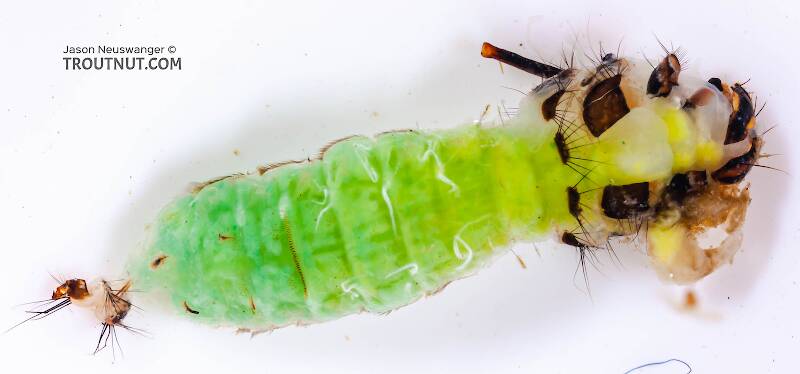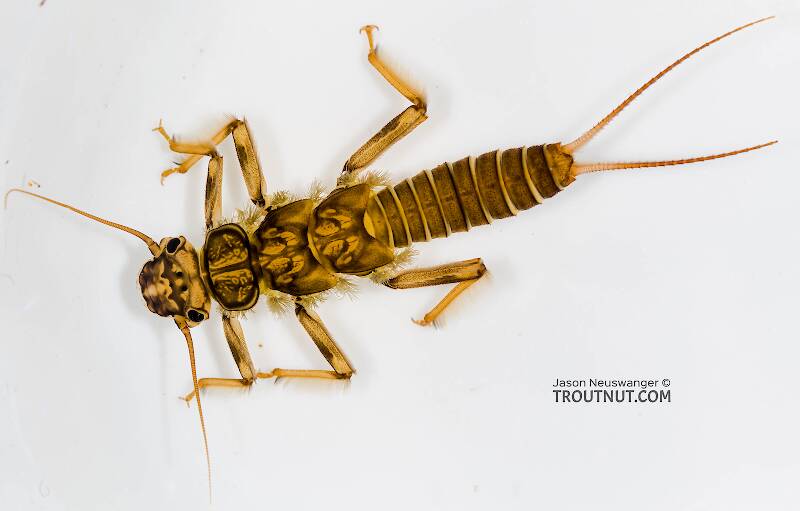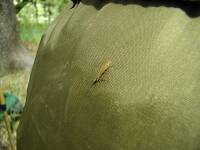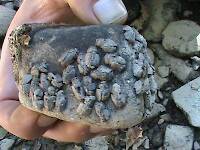
Hex Mayflies
Hexagenia limbata
The famous nocturnal Hex hatch of the Midwest (and a few other lucky locations) stirs to the surface mythically large brown trout that only touch streamers for the rest of the year.
Featured on the forum

Troutnut is a project started in 2003 by salmonid ecologist Jason "Troutnut" Neuswanger to help anglers and
fly tyers unabashedly embrace the entomological side of the sport. Learn more about Troutnut or
support the project for an enhanced experience here.

The green blob contained in this case is a pupa in the early stages of transformation from larva to the final stage we generally picture and imitate. This specimen and several like it were fixed to a rock I picked up, and each one had the front of its case sealed off, protecting the helpless pupa from predation. It's neat to see the insect part-way through such a radical transformation.
It was very hard to extract this thing from its case, so there's a bit of extra goo near the head from where I accidentally punctured it.
It was very hard to extract this thing from its case, so there's a bit of extra goo near the head from where I accidentally punctured it.
Dgracia
Posts: 3
Posts: 3
Dgracia on Jan 14, 2009January 14th, 2009, 2:01 am EST
Hi Jason,
[br][br]
One of the things I've done forever is carry at least a couple of fairly large (3"-4") darning needles in my vest. You can conveniently carry them inside one of your foam fly boxes or poked into a foam fly patch. Besides making a good fid (tool for opening knots) it also persuades caddis to come out of their cases generally in one piece. If you have the larva in your hand and he hasn't sealed the opening for pupation, you can just insert the blunt end of the needle (the part with the eye in it) in through the back of the case and slowly push. Pretty quickly, he will start coming out the front of the case and you can persuade him to come out entirely without much problem.
[br][br]
You can extract intact examples of the larva or pupa pretty easily with this method. With a pupating caddis, you do need to cut off the sealed opening so the caddis can get out. You have to be pretty careful though, because it's easy to cut off his head if you aren't.
[br][br]
Of course, you won't get those great photos of half-cut open cases, but you don't have to worry about breaking off legs either. I started carrying those needles with me when I was teaching so I could undo "wind knots" more easily, but they are great at persuading caddis to leave their case.
[br][br]
Dan
[br][br]
One of the things I've done forever is carry at least a couple of fairly large (3"-4") darning needles in my vest. You can conveniently carry them inside one of your foam fly boxes or poked into a foam fly patch. Besides making a good fid (tool for opening knots) it also persuades caddis to come out of their cases generally in one piece. If you have the larva in your hand and he hasn't sealed the opening for pupation, you can just insert the blunt end of the needle (the part with the eye in it) in through the back of the case and slowly push. Pretty quickly, he will start coming out the front of the case and you can persuade him to come out entirely without much problem.
[br][br]
You can extract intact examples of the larva or pupa pretty easily with this method. With a pupating caddis, you do need to cut off the sealed opening so the caddis can get out. You have to be pretty careful though, because it's easy to cut off his head if you aren't.
[br][br]
Of course, you won't get those great photos of half-cut open cases, but you don't have to worry about breaking off legs either. I started carrying those needles with me when I was teaching so I could undo "wind knots" more easily, but they are great at persuading caddis to leave their case.
[br][br]
Dan
Wbranch on Feb 13, 2013February 13th, 2013, 11:58 am EST
This green pupa looks a lot like the Bot fly larvae I've seen being removed from guy's heads on the Animal Planet. Pretty gross when the fly lays it's eggs on someone's head!
Catskill fly fisher for fifty-five years.
Troutnut on Feb 15, 2013February 15th, 2013, 4:00 pm EST
Thanks Dan, I'll try that.
Jason Neuswanger, Ph.D.
Troutnut and salmonid ecologist
Troutnut and salmonid ecologist
Quick Reply
Related Discussions
Topic
Replies
Last Reply
1
Aug 30, 2010
by GONZO
by GONZO






